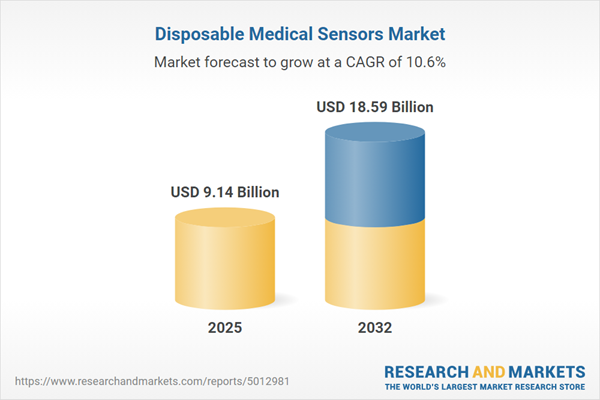Speak directly to the analyst to clarify any post sales queries you may have.
Disposable medical sensors are transforming healthcare delivery by simplifying patient monitoring, enhancing safety, and integrating seamlessly across care settings. Senior decision-makers increasingly recognize these devices as drivers of operational efficiency and clinical effectiveness.
Market Snapshot: Disposable Medical Sensors Market Growth and Opportunities
The disposable medical sensors market grew from USD 8.28 billion in 2024 to USD 9.14 billion in 2025. It is projected to maintain a compound annual growth rate (CAGR) of 10.63%, reaching USD 18.59 billion by 2032. This steady expansion is propelled by rapid innovation in materials science, electronics miniaturization, and advanced connectivity protocols. The evolving landscape balances rising care demands against infection control needs and operational cost pressures, making this market central to modern health systems worldwide.
Scope and Segmentation: Comprehensive View of Product Types, Technologies, and Regions
The report delivers actionable intelligence across all primary segments and regions:
- Product Types: ECG sensors (multi-channel, single-channel), glucose sensors (electrochemical, optical), pressure sensors (piezoelectric, strain gauge), and temperature sensors (digital, infrared).
- Technology: Bluetooth (Low Energy, classic), wired (direct cable, USB connection), wireless (cellular, Wi-Fi).
- Application: Chronic disease monitoring, postoperative monitoring, ICU and ward monitoring, cardiac and respiratory remote patient monitoring.
- End Users: Ambulatory care (outpatient clinics, urgent care), home healthcare (professional care, self-care), hospitals (private, public).
- Regions: Americas (United States, Canada, Mexico, Brazil, Argentina, Chile, Colombia, Peru), Europe, Middle East & Africa (United Kingdom, Germany, France, Russia, Italy, Spain, Netherlands, Sweden, Poland, Switzerland, United Arab Emirates, Saudi Arabia, Qatar, Turkey, Israel, South Africa, Nigeria, Egypt, Kenya), Asia-Pacific (China, India, Japan, Australia, South Korea, Indonesia, Thailand, Malaysia, Singapore, Taiwan).
- Companies Profiled: Abbott Laboratories, Medtronic plc, F. Hoffmann-La Roche Ltd, Dexcom, Inc., Masimo Corporation, Becton, Dickinson and Company, Cardinal Health, Inc., Nipro Corporation, 3M Company, Teleflex Incorporated.
Key Takeaways for Senior Decision-Makers
- Single-use sensor technologies address infection control while streamlining supply chains and reducing complexities present in reusable device management.
- Integration of miniaturized electronics, ultra-low-power components, and advanced connectivity enables continuous patient data capture within both acute and home settings.
- Adaptive regulatory frameworks and rigorous quality management are fostering faster commercialization and scalable adoption across markets with varying infrastructure readiness.
- Demand for multi-modal, biocompatible substrates is driving innovation in patient comfort, clinical outcomes, and operational workflows.
- Strategic partnerships between established manufacturers, technology firms, and startups are reshaping competitive advantage through bundled analytics, cloud integration, and data-driven services.
- Regional variations reflect differing reimbursement policies, healthcare infrastructure maturity, and local supply chain capabilities—with tailored entry and sourcing strategies recommended for success.
Tariff Impact: Strategic Responses to United States Tariff Adjustments
Forthcoming United States tariff adjustments are prompting manufacturers to adjust sourcing frameworks and diversify their operational footprints. These tariffs impact the procurement of critical sensor components such as semiconductors, flexible substrate materials, and optical elements. Companies are relocating assembly operations, securing forward contracts, and exploring domestic partnerships to cushion cost increases and maintain product availability. Robust demand forecasting and agile inventory management are now essential to minimize potential shipment delays and mitigate customs-related disruptions in healthcare delivery.
Methodology & Data Sources
This analysis combines structured interviews with clinicians, procurement specialists, and developers alongside thorough reviews of regulatory documents and technical literature. Quantitative data extraction and thematic coding ensure reliability and contextual relevance. Peer review by independent experts and transparent documentation enhance the methodological rigor and reproducibility of all findings.
Why This Report Matters: Actionable Intelligence for Stakeholder Success
- Provides in-depth, segmented analysis to guide investment, sourcing, and portfolio decisions in the evolving disposable medical sensors sector.
- Delivers region- and end-user-specific competitive intelligence to inform go-to-market strategies, technology adoption, and risk mitigation in a rapidly changing global context.
Conclusion
Disposable medical sensors are strengthening patient-centred healthcare, improving operational efficiencies, and minimizing infection risks. Market leaders prioritizing supply chain resilience, regulatory agility, and continuous product innovation will sustain a competitive position as this sector evolves.
Additional Product Information:
- Purchase of this report includes 1 year online access with quarterly updates.
- This report can be updated on request. Please contact our Customer Experience team using the Ask a Question widget on our website.
Table of Contents
3. Executive Summary
4. Market Overview
7. Cumulative Impact of Artificial Intelligence 2025
Companies Mentioned
The companies profiled in this Disposable Medical Sensors market report include:- Abbott Laboratories
- Medtronic plc
- F. Hoffmann-La Roche Ltd
- Dexcom, Inc.
- Masimo Corporation
- Becton, Dickinson and Company
- Cardinal Health, Inc.
- Nipro Corporation
- 3M Company
- Teleflex Incorporated
Table Information
| Report Attribute | Details |
|---|---|
| No. of Pages | 191 |
| Published | November 2025 |
| Forecast Period | 2025 - 2032 |
| Estimated Market Value ( USD | $ 9.14 Billion |
| Forecasted Market Value ( USD | $ 18.59 Billion |
| Compound Annual Growth Rate | 10.6% |
| Regions Covered | Global |
| No. of Companies Mentioned | 11 |









